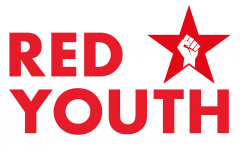Red Youth salutes the revolutionary women of the world! Our young cadre will be publishing short pieces all this week to celebrate our revolutionary heroines in the run up to International Women’s Day. Today Jamie, aged 25, discusses Constance Markiewicz.
Red Youth will be meeting to celebrate International Women’s Day on 9 March, at 1.00pm, at the CPGB-ML party centre 274 Moseley Road, Highgate, Birmingham.
I did what I thought was right and I stand by it.
– Constance Markiewicz
Revolutionary socialist was not an obvious vocational choice for Constance Markiewicz. The eldest daughter of Arctic explorer Sir Henry Gore-Booth, an Anglo-Irish protestant landlord, and Lady Georgina Gore Booth, Constance was born into relative privilege.
She was a talented artist and studied at the prestigious Académie Julian in Paris, where she met her future husband, Count Kazimierz Markiewicz, a Polish nobleman.
Yet, within this affluent upbringing, there lay confronting experiences that began to shape Constance’s political outlook:
- Her father, a wealthy landlord, offered free food to local people during the agonising and genocidal British imperialist-engineered Great Famine between 1840-52.
- Constance and her sister Eva were childhood friends of the poet WB Yeats, who was a member of the Irish Republican Brotherhood.
- She had interactions with progressive movements, including suffragettes, as a student in London and Paris.
- The creation of the Gaelic League – a formally apolitical group concerned with the preservation of Irish culture, but which comprised many nationalists and future political leaders – offered further exposure to radical ideals.
And, as is claimed in folklore, Constance rented a small cottage in the countryside outside Dublin. The previous tenant, poet Padraic Colum, left behind copies of revolutionary journals such as The Peasant and Sinn Fein, which promoted Irish freedom from British imperialism.
These experiences inspired a transformation from a life of privilege to a commitment to economic, political and social equality for all.
The years 1908-09 saw a rapid development of Constance’s political activities: she joined Sinn Fein and Inghinidhe na hÉireann (Daughters of Ireland); travelled to Manchester to support the suffragettes’ successful attempt to oppose Winston Churchill’s election to parliament; and – of vital importance to the cause of Irish liberation – created a paramilitary youth movement, Fianna Éireann, to educate teenage boys and girls on the use of firearms.
Soon after, in 1913, Ireland experienced the most severe industrial dispute of its history. The Dublin Lock-out was the culmination of a series of industrial struggles that aimed to win trade-union rights for workers. Irish workers lived in some of the worst conditions in all of Europe; the mix of slum housing, poor sanitation and little access to health care made the rapid spread of disease, including tuberculosis, inevitable. In this context, the workers, lacking any representation, were brutally exploited by the industrial capitalists.
James Larkin, the talented organiser and orator, recruited many into the Irish Transport and General Workers Union (ITGWU), and demanded improved conditions. Whilst wealthy capitalists locked unionised workers out of their jobs, starving them, and employed blackleg labour from Britain and elsewhere in Ireland, the struggle had two crucial legacies: it developed the culture of industrial action and trade unionism in Ireland; and introduced socialist ideals firmly in the context of Irish nationalism and the question of Home Rule.

Constance Markiewicz supported the workers throughout the seven-month lock-out by organising voluntary food production and distributing it amongst the hungry and destitute families. This activity was self-funded by selling many of her own possessions.
Markiewicz also encountered the legendary Marxist James Connolly during this period. Connolly had formed the Irish Citizens Army (ICA) to defend the workers from police brutality; several hundred had been savagely beaten by the authorities during the lock-out. She quickly joined the ICA and injected it with her interest in culture – designing a military uniform and creating songs to professionalise and inspire the army.
The Irish Citizens Army went on to play a central role in the Easter Rising of 1916. This extraordinary event, again, placed socialism and the demand for equality at the heart of the national independence movement.
Markiewicz did not assume a secondary or subservient role – as early 20th-century society may have expected – but served as an armed lieutenant, directing her own unit, supervising the barricades, personally wounding a British sniper and holding her position for six days.
The rebellion was suppressed by British bombs and the leaders surrendered after the military had destroyed large parts of Dublin. However, as with the Dublin Lock-out three years earlier, the Easter Rising’s success was not its immediate material gain, but the legacy of inspiring generations of Irish men and women to fight for freedom against British imperialism.
It also demonstrated to the people of Europe, notably the Bolsheviks of Russia, that turning your guns on your real enemy – imperialist, colonialist states – and away from other working-class people during the first world war (1914-18) was a most revolutionary act.
Markiewicz was sentenced to death, along with other leaders, including Connolly, for her role in the rebellion. This was later converted to life imprisonment after the British feared that executing a woman would prompt further social unrest. In court she proclaimed: “I do wish your lot had the decency to shoot me.”
In the 1918 general election, after being released as part of an amnesty, Constance Markiewicz was elected as MP for Dublin St Patrick’s constituency. This made her the first woman ever elected to the House of Commons. She, in accordance with Sinn Fein policy, refused to take a seat in the British parliament.

The remarkable life of Constance Markiewicz continues to inspire countless young people. Whilst the capitalists tolerate – and even manipulate and revere – ‘charitable’ women, they despise revolutionary ones. They fear nothing more than women who are committed to education, organisation and liberation.
Markiewicz infused national independence with socialism; republicanism with feminism; and charity with empowerment. She is an example to revolutionaries everywhere.

